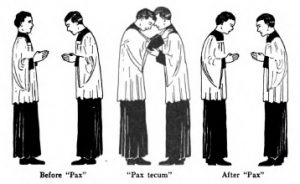 Today my friend Fr. John Hunwicke has a stunner of a post in which he detonates and explodes the present day commonly chaotic infra dignitatem group-grope “Sign of Peace” during Holy Mass.
Today my friend Fr. John Hunwicke has a stunner of a post in which he detonates and explodes the present day commonly chaotic infra dignitatem group-grope “Sign of Peace” during Holy Mass.
First, he writes of period during which the Our Father was introduced in to liturgical worship. Previously, it had not been considered liturgical prayer. However, after it’s introduction in liturgical worship, it was followed by a kind of “signing off” on what had preceded, a “signaculum orationis“.
Father writes:
It seems highly likely that what happened is this. When the Our Father was introduced into the Mass, it brought with it its concluding signaculum, the Kiss of Peace. Thus the Pax in the Liturgy is not, in itself, a reconciliatory preparation for Communion, but a ‘signing off’ from the Our Father and the Eucharistic Prayer. We find this situation reflected in the Letter of Pope S Innocent I to the Bishop of Gubbio in 416 (PL 56 515). Troublemakers [never lacking in any epoch] in Gubbio had been saying that it was better to follow the custom of another Church as to the position of the Peace rather than that of Rome; [plus ça change] the Pope responds ‘ the Pax has to be done after all the things which I’m not allowed to mention to show that the people have given their consent to everything which is done in the mysteries and celebrated in Church, and to demonstrate that they are finished by the signaculum of the concluding Pax‘. The fact that he employs the very term signaculum which had been used by Tertullian suggests that we are dealing with conventional usage widespread enough to be common to Rome and North Africa and over a period of at least two centuries.
He also explores the historical question of fast days and the exchange of the Pax, and he wraps up with lots of questions. In conclusion, however, he adds:
I never cease to be surprised at what I find whenever I delve back into the history of the venerable and wonderful Roman Rite.
Do I hear an “Amen!”?
Fr. Z kudos to Fr. H. I’ve compressed this a great deal. You should go over there and read the whole fascinating thing.
That said, one might use Father’s post as part of a series to catechize a parish about a proper way to give the sign of peace.
Ratification of what has gone before or reconciliation before Communion. Of course the one does not automatically exclude the other.


































Looking at the picture, I wonder if it is correct as drawn there. I had learned that the superior lays his hands on the upper arms (not shoulders) of the minor one, and the minor one as drawn puts his hands on the elbows of the superior. Or exist several customs of it?
The post is very interesting (as Fr H’s posts always are), but I don’t see that the handshake malarkey that exists today to be in any way an exchange of peace or even a sign of it. Perhaps if there were a proper, formal, sign of exchanging peace I would object less (perhaps, perhaps not), but what we have today in parishes is an idiocy.
Very interesting! I had never heard of this. Hopefully the norm for Catholicism will go back to shake the hands of the two people on your side. I didn’t mind the Pax, but things seem to keep degenerating around here, and when you can’t even concentrate during the Lamb of God because someone five rows behind you comes to shake your hand, enough is enough. I suppose a bit of catechism on the Mass wouldn’t hurt anyone.
Pingback: FRIDAY CATHOLICA EDITION | Big Pulpit
This is something that my parish does not do except for Solemn High Masses and then never leaves the Sanctuary. In my old OF parish, it got so carried away that I’d just press 5 to 5 and bow my head.
This I have trouble understanding.
What I do understand is silence and reverence.
Thank you, Cardinal Sarah.